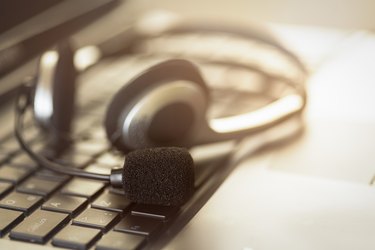
Bose, best known for its noise-cancelling headphones and high-quality speakers, also makes two lines of headsets. The first line includes four aviation headsets, including the A20, the newest in this line as of the time of publication. The other Bose headset line incorporates Bluetooth technology; this includes the Series 2 headset, the newest of Bose's two Bluetooth headsets. Clicking in these headsets may be caused by the products themselves or the equipment to which they're connected.
Charging & Changing the Battery
Video of the Day
Although both the A20 aviation headset and the Series 2 Bluetooth headset use batteries to power the unit, the A20 uses a standard AAA battery while the Series 2 uses an internal rechargeable battery that's installed by the manufacturer. The Series 2 headset has indicator lights that change from green to red, indicating an increasingly drained battery, which can be recharged by connecting the headset to a computer or wall socket using a USB cable or power adapter. On either headset, a battery that needs to be recharged or replaced can interrupt the flow of power to the unit itself, resulting in clicking, ticking and other audio issues.
Video of the Day
Aircraft Connection
In addition to running off its own battery, the A20 can also connect directly to an aircraft using a variety of cable connectors, including dual G/A, 6-pin install, 5-pin XLR and U174 technology. If you are using one of these cables to connect your A20 headset to your aircraft, make sure they are correctly attached, both to the input port at the base of left ear piece and the input port on your aircraft. Also, examine the cable itself for any damage that could create interference resulting in clicking sounds.
Bluetooth Connection
The Series 2 headset, as well as certain A20 headsets, are Bluetooth enabled. In order to use this feature, you must pair the headset with a cellphone, smartphone or other Bluetooth enabled device. To do this on the Series 2, press the "Call" button on the headset. On the A20, press and hold the Bluetooth Function button for five seconds: this will put your headset into discovery mode and force it to search for the other Bluetooth-enabled device. If you do not properly pair your headset with your Bluetooth-enabled device, the headset may produce a clicking noise while it searches for the signal from the Bluetooth; it may also produce this sound if your Bluetooth device is not turned on or if the signal originating from the Bluetooth is not strong enough.
Defective Parts
The A20 uses ear cups, while the Series 2 uses a single ear tip, to relay the sound to your ear. If these ear cups or tip become dirty or damaged, the clarity of your audio signal will be compromised. Bose offers replacement cups and tips, as well as instructions on how you can change them. The mouthpiece on the A20 has a windscreen, and if this is ripped, it can create a crackling sound in the headset when you talk or are in high-wind areas. This can also be replaced to ameliorate the ticking problem. Finally, damaged wires within the headset also lead to audio issues, but tampering with this circuitry nullifies Bose's warranty. If you come across a problem you can't fix through troubleshooting or replacing a defective part, contact Bose customer service at 1-800-414-8266.
- Bose: Product Service - Bluetooth Headset Series 2
- Bose: Charging the Headset
- Bose: Pairing the Headset with Your Device
- Bose: Bluetooth Headset Series 2 Owner's Guide
- Bose: A20 Aviation Headset
- Bose: A20 Aviation Headset Owner's Guide
- Bose: Pairing a Bluetooth-enabled Device
- Bose: Installing the Battery